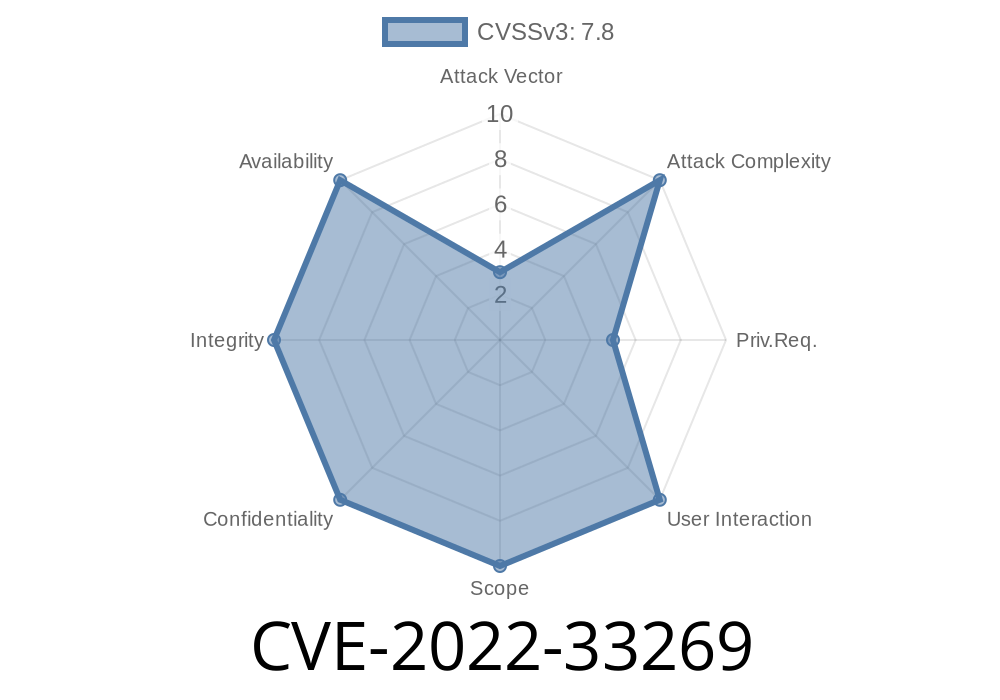Memory corruption bugs continue to haunt embedded platforms, and CVE-2022-33269 is a notable example of such a vulnerability—one with potentially serious consequences if exploited. In this post, we’ll walk through the details of CVE-2022-33269, which arises from an integer overflow (also called wraparound) in Qualcomm Core when assigning DDR memory. We’ll break down why this bug happens, how it can be exploited, and some simple demonstration code. You'll also find direct links to the original advisories and further reading.
What is CVE-2022-33269?
CVE-2022-33269 is a security flaw found in certain versions of Qualcomm Core, which is a crucial chunk of code that runs deep in Qualcomm Snapdragon-based chips, powering Android phones and other embedded devices. The bug occurs during DDR (double data rate) memory assignment because of improper handling of large integer values—specifically, an integer overflow that leads to memory corruption.
In plain words:
The system tries to do math on memory addresses but doesn't check if the numbers get too big. If they do, they "wrap around"—meaning, the number loops back to zero. This can cause the system to write somewhere it shouldn't, letting attackers potentially take control.
During DDR memory assignment, code like this is often used
size_t offset = get_input_offset();
size_t size = get_input_size();
void *base = memory_region.base;
if (offset + size > memory_region.len) {
return ERROR; // check for overflow, should validate properly
}
void *address = base + offset;
memcpy(address, input_buffer, size);
The mistake:
If offset and size are both large, offset + size could wrap around to a small number because of integer overflow. The check may pass, but the code could then write data outside the intended memory, leading to corruption.
Realistic unsafe code
// Unsafe: integer wraparound not handled
if (offset + size > memory_region.len) {
// Supposed to check if write goes out of bounds
return ERROR;
}
Proper safe code should check for overflow before doing arithmetic
// Safe: check for overflow first
if (size > memory_region.len - offset) {
return ERROR;
}
Example Exploit Scenario
An attacker who can control the offset and size (e.g., via a system call or crafted packet) sends massive values. The vulnerable code adds them up. The sum is smaller than expected because the integer “wraps around.” The copy then happens at a wrong, possibly privileged, memory location.
Sample Exploit Code (Demo)
Here’s a simulated example using C (note: this is only a demonstration; actual exploitation would depend on the affected code and system):
#include <stdio.h>
#include <string.h>
#include <stdint.h>
#define REGION_LEN 1024
int main() {
uint8_t memory_region[REGION_LEN] = {};
size_t offset = xFFFFFFF; // Huge offset (simulate user input)
size_t size = 32; // Small size
uint8_t input_buffer[32] = {1,2,3,4,5};
// Vulnerable check
if (offset + size > REGION_LEN) {
printf("Error: Out of bounds\n");
return 1;
}
// This address will wrap due to integer overflow!
memcpy(memory_region + offset, input_buffer, size);
printf("Memory write completed (potentially out of bounds)\n");
return ;
}
Result:
Despite the check, offset + size can wrap, so the write will hit an unexpected part of memory.
Official Qualcomm Security Bulletin:
Qualcomm Security Bulletin June 2022
NVD CVE Detail:
Integer Overflow Explained (Simple):
OWASP: Integer Overflow or Wraparound
Memory Corruption Primer:
Exploitability and Impact
The biggest risk is to privilege boundaries. If the attacker finds a way to reliably trigger the overflow and control source data, sensitive memory can be changed or read. Exploits in the wild would be rare but possible on unpatched devices—especially on older Android phones using affected Qualcomm chipsets.
Conclusion
CVE-2022-33269 reminds us how easy it is to make dangerous mistakes with numbers in C code, especially in low-level system programming. A missing overflow check can turn a simple calculation into a security nightmare. If you write embedded software, always validate and sanitize user-controlled values before using them in pointer or memory operations.
Timeline
Published on: 04/13/2023 07:15:00 UTC
Last modified on: 04/24/2023 16:14:00 UTC
